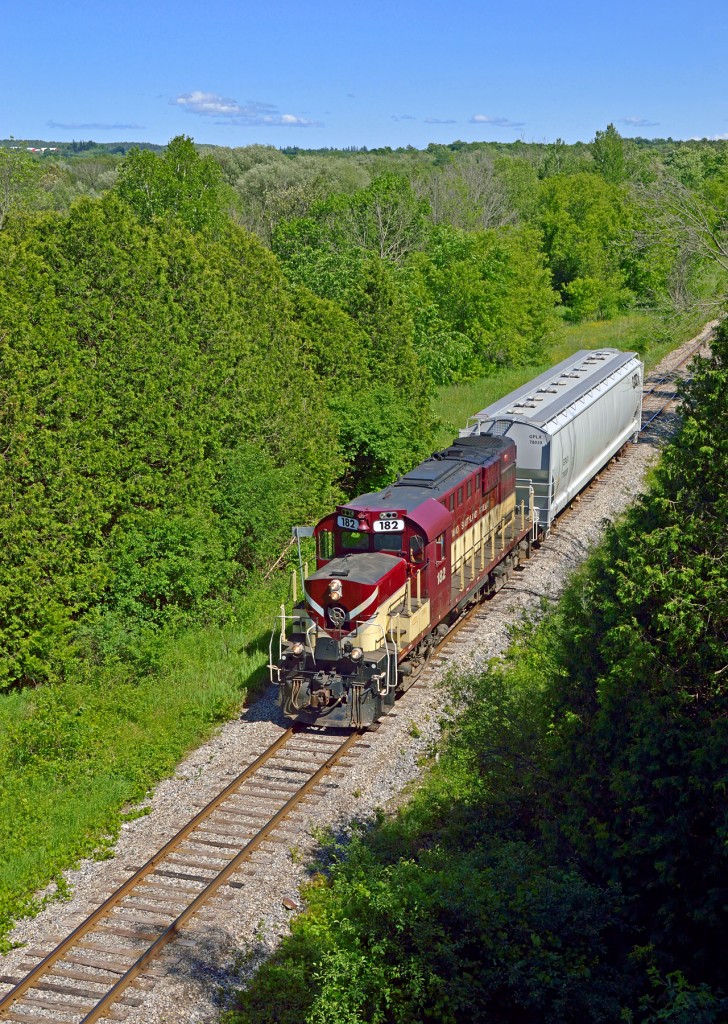|
Caption: With a lone car for PDI Elizabeth in tow, OSR's 1400 job approaches Guelph at a place once known as Speedwell. Located at mile 29.6 on the Goderich sub (page 9), Speedwell was a flag stop for the CPR, the Toronto Suburban Railway, and the Guelph Radial Railway; the latter two being electric lines.
Built under the direction of Sir William Mackenzie and Sir Donald Mann (of Canadian Northern Railway fame), the Toronto Suburban Railway's Guelph Line ran 49.4 miles from Toronto at St. Clair and Keele Street through towns including Cooksville, Meadowvale, Georgetown, Eden Mills, and Guelph. There was 100 stops along the line, many likely at farmers' crossings lacking any formal station. Mackenzie & Mann's aim of building quality lines at low cost saw the line built with 60lb rails, weaving west through many curves and over large bridges including the 711-foot long Humber River bridge and a 315 foot wooden trestle across the Credit River near Norval, until reaching the Guelph terminus at the Grand Trunk Railway station on Carden Street via a connection with the Guelph Radial Railway at Dundas Street and Bay Street; now renamed Gordon Street and James Street East. A storefront on Carden Street (behind train here) across from GTR's station provided TSR customers with a place to purchase tickets. Being a longer interurban line, the TSR cars on the Guelph Line were larger, constructed by the Preston Car and Coach Co, described as a "68-seat affair and nicely appointed with cherry wood finish throughout, comfortable green, plush, upholstered, high-backed seats with headrests, footrests and polished bronze handles on the aisle sides." The first car over the line arrived in Guelph on Thursday, August 12, 1917 with management and foreman aboard, declaring on arrival, that the line would open to the public that Saturday, August 14. The intended destination of the Guelph Line after surveying during 1911 was originally Berlin, now Kitchener, however restrictions and costs during WWI resulted in the destination of Guelph. Three hydro substations were built to supply the line with 1,500 volt D.C. but only 2 (Islington, Georgetown) were ever used. The third, located in Guelph on Bay Street was built for the Kitchener end of the line, but was not needed after cutbacks. The building is now a private residence. In September, 1918, Mackenzie and Mann amalgamated the TSR with the Canadian Northern Railway ultimately becoming the Toronto Suburban Division of the Canadian National Electric Railways on December 17, 1923. With the rise in ownership of the automobile, faster schedules provided by both Canadian National and Canadian Pacific Railways, and reduced service due to the Great Depression, the CNR chose to discontinue service on the Toronto Suburban Railway Division by allowing it to enter receivership. The last day of service was August 15, 1931 and the line was dismantled in late 1935 after the debts were paid. Today, a short stretch of the line has been rebuilt in the form of the Halton County Radial Railway on Guelph Line in Eden Mills. Just up the line from OSR here, the TSR crossed the CPR at a diamond before passing under Victoria Road. PDI's Bulk Liquid facility is now just out of frame to the right across the river.
The Guelph Railway Company was chartered in 1894 by businessman George Sleeman of the Silvercreek Brewery to provide his employees, and the City of Guelph, with an easier way to get to work. Construction began in early 1895 with service beginning on September 17, 1895 centered around St. George's Square. Freight service would begin in 1900. The line ran throughout Guelph's streets under different owners; Sleeman, 1895-1902; Bank of Montreal and Trader's Bank of Canada, 1902-1903, renamed Guelph Radial Railway; City of Guelph, 1903-1921: Ontario Hydro, 1921-1936. Under the latter the name was changed to Ontario Hydro Electric Railways - Guelph District. Beginning in 1926 buses began service on many routes to supplement the cars, or replace the streetcars where track conditions were poor. Ontario Hydro attempted to sell the line back to the city, but they wanted no part in it. Streetcar service would end in Guelph on September 30, 1937. Electric freight service continued until May 26, 1939; the same year the company, now all buses, would be renamed Guelph Transportation Commission. Guelph Radial service to Speedwell was provided on Sundays only when the TSR traffic would be light. The station was accessed over the TSR line from Dundas/Bay Streets east to the station. The area was used by many for for fishing, picnics, or visiting people at the Ontario Reformatory. A complete Inventory of Shop Tools & Car Equipment of Guelph Radial Railway from December 1920 can be found here.
Just across the river from my photo lies the former Ontario Reformatory/Guelph Correctional Centre Prison Farm, in use from 1909 - 2002, the farm shutting down in 1972. The prison was constructed of stone quarried onsite by the inmates and the quarry expanded to provide material to other construction projects. The prison was serviced by the CPR on a spur running across the river to deliver coal and a switchback to lift cars of stone and gravel from the quarry loader. Inside the quarry was a narrow gauge railway built on 25lb. rail temporary tracks that could be moved where they were needed. The locomotive was a 12 ton H. K. Porter 0-4-0 named 'Liz' built in 1911 and operated by the inmates. 1917-1920 saw the reformatory used as the Speedwell Convalescent Hospital for returning veterans, helping to heal them and aid in their return to civil life. This was short-lived however as the conditions inside the hospital worsened with a lack of upkeep brought on by embezzlement, and the decision was made to revert the hospital to a prison.
Speedwell, a place at one time having a class 1 railway, an electric railway served by two operators, and a narrow gauge railway all within 1/4 miles or less of each other.
|


